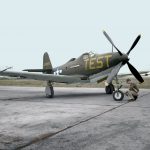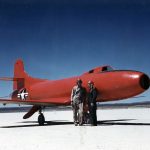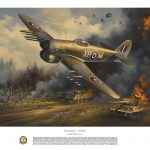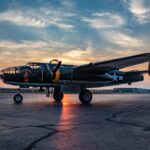The North American A-36A was a derivative of the British Mustang I. The name ‘Apache’ was applied by North American Aviation (NAA) and never officially adopted by the USAAF. The A-36 was fitted with a 1,325hp Allison V-1710-87 engine that gave the aircraft incredible performance below 12,000 feet. This new dive-bomber could easily reach 500 mph in a dive, but to limit the Apache’s dive speed to 390 mph NAA engineers added dive brakes to the top and bottom of the wings. Armament consisted of six Browning 0.50 caliber machine guns, four in the wings and two in the nose, and bomb shackles under the wings.
The first combat units to deploy and take the Apache into combat were the 86th Fighter-Bomber Group (FBG) & 27thFBG, which arrived in North Africa in May & June 1943, respectively. The Apache dove into combat for the first time during a raid on the island of Pantelleria on June 6, 1943. The only other group to receive the A-36 was 311th FBG in the China-Burma-India (CBI) Theater. The 311th, based at Nawadih, India, was comprised of the 528th, 529th, and 530thFighter-Bomber Squadrons (FBS). The 528th & 529th operated the A-36 while the 530th was equipped with P-51As. The 311th, along with the 23rd FG, were the first Mustang units to take the fight to the Japanese in September 1943.
The common tactic of A-36 units was for each aircraft to deploy its dive brakes and peel off into a follow-the-leader dive maintaining about 150 foot separation. With this tactic it was not uncommon to see twenty Apaches in a dive at the same time. Eyewitnesses said that the scream of a diving A-36 was far more terrifying than a Ju 87 Stuka.
Although it was a ground attack aircraft, Apache pilots claimed 80+ aerial victories. The most successful squadron was the 522nd FBS (part of 27th FBG), which achieved 30 victories and produced the only A-36 Ace of the war- Lt Michael T Russo, who was credited with two FW 190s, a Fiesler Storch, a Ju-52, and a Bf109. In early 1944 the 27th FBG became the first unit to dispose of its A-36s in favor of P-40 Warhawks, followed by the 86th in June. In the CBI the two Apache squadrons in the 311th had converted to P-51s by the end of 1944.
On December 15, 1942, the A-36A-1-NA carrying USAAF #42-83731 rolled off the North American assembly line. The next day the aircraft was flown to Long Beach Army Airfield (AAF), home of the Army Air Transport Command’s Ferrying Division, to await assignment. On New Year’s Eve 1942 ‘731 was assigned to the 3rd Composite Squadron at Lawson AAF, Georgia, the squadron operated a wide variety of aircraft to provide aerial support for the nearby infantry school.

The aircraft was soon transferred to Key Field, Mississippi as a training aircraft for members of the 48th Bombardment Group (Light). On March 9, 1943, the aircraft was damaged in a ground loop accident with 2nd Lieutenant Donald W. Goerke at the controls. At that time Lt Goerke had logged 335 hours of flying time and 54.3 hours in the A-36. After landing safely on Runway 1/19, Goerke was taxiing back to the ramp on Runway 4/22 when the Apache began to ground loop to the right. Lt Goerke attempted to correct the ground loop by applying left brake, however his brake application was too hard, and the A-36 ended up on its nose with a bent propeller. Goerke was uninjured and the Apache was subsequently repaired.
In May 1945 the weary A-36 was turned over to the Reconstruction Finance Corporation for disposal. The Apache spent several decades in storage while it passed through several owners until it was finally acquired by Dick Martin of Carlsbad, California. The Apache was purchased by Friedkin Enterprises on November 28, 1977, and Martin was tasked with the restoration. The Apache made its first post-restoration flight from Palomar Airport in the summer of 1981. At this time the aircraft had 1,320 hours total time and test flights added only 5 hours to the clock by February 1982. Between 1991 and 2001 the A-36 was displayed at Champlain Fighter Museum in Mesa, Arizona and Lone Star Flight Museum in Galveston, Texas.
In 2002, the aircraft was disassembled and shipped to England where it was flown at Duxford’s Flying Legends airshow. Upon its return to the United States the dive bomber was placed in storage at Chino having flown just 48 hours in the last 21 years. It was pulled out of storage in 2006, refurbished by Fighter Rebuilders, and debuted in bare metal at the 2010 Planes of Fame airshow. Today, this beautifully restored A-36 is among the rarest of all Mustang variants as only three examples remain, with this being the only airworthy aircraft.
The Friedkin family spent several months choosing a paint scheme for their Apache. In 2011 they settled on A-36A USAAF #42-84071 of the 527th FBS/86th FBG, a veteran of over 200 combat missions. Activated February 10, 1942, the 86th FBG was the first A-36 unit to arrive in the MTO in March 1943. In 15 months of A-36 operations the group softened up defenses on Sicily, supported the July 1943 invasion by the Seventh Army, covered the invasion of Salerno in September, and supported Allied troops in the final push towards Rome. In addition to close air support missions the 86th flew their Apaches with devastating effect against Axis convoys, trains, ammunition dumps, shipping, and bridges.
In May 1944 the 527th FBS was based at Marcianise, Italy. On May 9, 1944, 2nd Lt David A. Waterman took off on a close air support mission in ‘071. This was Waterman’s 37th combat mission; he was slated to become a flight leader within the next few days. In an area approximately 5 miles Southwest of Manziana, Italy Waterman’s aircraft was hit by anti-aircraft fire and began streaming coolant. Pilots in his flight saw Waterman bail out of his stricken Apache and wave to them after he landed behind enemy lines. Waterman was captured by the Germans and spent the remainder of the war as a POW. He was repatriated after the war. The loss of Lt Waterman was just the beginning of a difficult month for the 527th. In the 491 sorties flown by the 527th that month the squadron suffered 2 pilots KIA, 6 KIA, and 1 WIA.
Judging from the May 12, 1944, entry in the 86th’s War Diary the squadron was less than thrilled with turning in their A-36s for P-40s. “Blue Friday for the squadron…we are now proud posessors [sic] of mighty Warhawks. The 527th is to turn over 36’s to other two squadrons and fly P-40’s. Old P-40F’s but new to our mechanics and pilots; will take a few days to get ships and pilots “checked out.”
When Dan Friedkin touched down at Davis-Monthan AFB, Arizona for the 2012 Heritage Flight Conference it marked the first appearance of a North American A-36A Apache in the 15-year history of the Heritage Flight Program. The A-36 is but a footnote in both the story of the Mustang and the history of World War II. In the early months of the war when Allies were just beginning to repel the Axis powers, the Apache earned its battles scars in a gritty ground war and blazed a pioneering warpath for the gleaming, high-flying Mustangs that “won the war” high over Berlin and Tokyo.




























